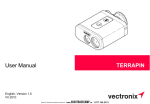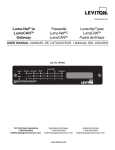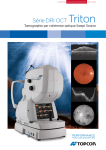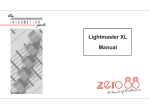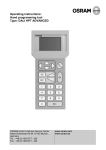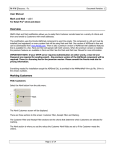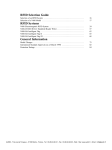Download UNI-T UT501 Unit installation
Transcript
I/F 501 INTERFACE UNIT INSTALLATION AND OPERATION GUIDE Software Revision 1.05, Version A INTRODUCTION The I/F 501 interface unit allows a variety of comunication protocals used in NSI and other industrial equipment to be translated between one another. In addition the I/F 501 can serve as an independent, programmable lighting controller. The I/F 501 also serves as the interface between NSI’s Luma-net network and a personal computer. SPECIFICATIONS: Microplex Input (I/O) 3 pin XLR male Microplex Ouput (I/O) 3 pin XLR female DMX 512 Input 5 pin XLR male (USITT spec) DMX 512 Output 5 pin XLR female (USITT spec) AMX 192 Output (optional, replaces 512) 4 pin XLR female (USITT spec) RS-232 I/O 9 pin ‘‘D’’ connector MIDI input / Analog input 5 pin din 180 degree connector Luma-net I/O Modular style telephone connector Power requirements +15VDC 200ma (power supply included) IMPORTANT Although many different connectors are present on this unit, in most configurations, one or more of the connectors may serve no function. It is important that the installer verify that the required inputs and outputs operated in the mode required for the application. Please read the appropriate application sheets in this manual carefully before installing. INTERFACE UNIT Software Revision 1.05, Version A Front Panel Front Panel 1 DC Power input - Connect 15VDC (+ tip, - ring) 250ma here. (Supplied with unit.) 2 Address - Controls translation of adresses (and other special functions). See individual applications details. 3 Config - Determines the operating mode of the unit. 4 PWR - Indicates presence of +15VDC 5 STAT - Usually indicates presence of input signal. 6 ERR - Indicates an input signal error. 7 MIDI/ANALOG - Midi input or analog input depending on application. 8 LUMA-NET I/O - Connects to a Luma-net network. 9 RS-232 - Connects to a personal computer. Rear Panel 1 MICROPLEX IN - Input Microplex here. Also may serve as pass- through I/O in some applications. 2 MICROPLEX OUT - Output Microplex here. Also may serve as pass-through I/O in some applications. 3 DMX 512 IN - Input DMX 512 here. 4 DMX 512 (AMX 192) OUT - Output DMX 512 here (or optionally AMX 192). NSI CORPORATION 2 INTERFACE UNIT Software Revision 1.05, Version A JUMPER JUMPER LOCATIONS LOCATIONS PCB locations of jumpers / internal connectors NSI CORPORATION 3 INTERFACE UNIT Software Revision 1.05, Version A JUMPER LOCATIONS I/F 501 JUMPER CHANGE QUICK REFERENCE CHART INPUT -> OUTPUT DEFAULT SETTINGS MPX -> DMX MPX -> AMX DMX -> MPX MIDI -> MPX/DMX MIDI -> AMX RS-232 -> MPX/DMX RS-232 -> AMX LUMANET/MPX/DMX -> MPX LUMANET/MPX -> DMX LUMANET/MPX -> AMX MPX/DMX/ANALOG -> MPX/DMX MPX/DMX/ANALOG -> AMX AUTO-CHASE -> MPX RS-232 AUTO-CUEING -> MPX/DMX IF-501 (AS 404CP) -> LUMANET RS-232 -> LUMANET CONFIG P4 P7 JP1 SWITCH P5 d-down u-up 1234 dddd OFF ON 6 dddd uddd OFF dudd ON uudd 2 ddud OFF 2 udud duud OFF uuud ON 2 dddu 2 uddu OFF 2 dudu uudu OFF dduu uduu duuu uuuu JP6 JP7 JP8 JP10 JP11 JP12 DMX JP9 OUT CONN 2-3 2-3 2-3 2-3 1-2 JP4 JP3 1-2 1-2 1-2 1-2 2-3 2-3 1-2 1-2 JP3 JP3 JP3 JP3 1-2 1-2 1-2 1-2 1-2 1-2 Set to default settings, then change as indicated for specific mode. MPX = N.S.I. Microplex JP13 = 2-3 DMX = DMX-512 MIDI = Musical Instrument Digital Interface AMX = AMX-192 P6 = OFF (no termination) or ON to terminate DMX lines RS-232 = RS-232C Serial data protocol LUMANET = N.S.I. Lumanet architectural protocol ANALOG = 0 - 10 VDC continuous voltage control P8 = OFF (no termination) or ON to terminate Lumanet lines IF-501 = N.S.I. protocol translator / controller 404CP = N.S.I. architectural control panel NSI CORPORATION 4 INTERFACE UNIT Software Revision 1.05, Version A PINOUTS PINOUTS Pinouts of the various connectors NSI CORPORATION 5 INTERFACE UNIT Software Revision 1.05, Version A MICROPLEX TO DMX 512 MICROPLEX TO DMX 512 In this application, Microplex is converted to DMX-512. The Microplex is then retransmitted. P4 & 5 OPEN P7 CLOSED JP6 & 7 N/A P6 N/A C1 DN C2 DN C3 DN C4 DN JUMPER LOCATIONS JP8 & 9 JP10 JP11 N/A 2-3 2-3 P8 JP1 N/A N/A JP12 JP13 N/A 2-3 DMX OUT CABLE JP4 DIPSWITCH POSITIONS ADDRESS 1 - 7 NOT USED CONNECTOR Microplex IN Microplex OUT DMX IN DMX out MIDI / Analog Luma-net RS-232 A8 DN:64 OPERATION Input Microplex Retransmitting Microplex (64 or 128) Not used Output DMX 512 Not used Not Used Not Used Microplex is converted channel to channel so address is not used. DMX output is sent as either 64 or 128 channels, depending on the setting of switch A8. NSI CORPORATION 6 INTERFACE UNIT Software Revision 1.05, Version A MICROPLEX TO AMX 192 MICROPLEX TO AMX 192 In this application, Microplex is converted to AMX-192. The 5 pin XLR may be replaced with a 4 pin XLR (USITT) if desired. P4 & 5 OPEN P7 OPEN JP6 & 7 N/A P6 N/A C1 UP C2 DN C3 DN C4 DN CONNECTOR Microplex IN Microplex OUT DMX IN *DMX out MIDI / Analog Luma-net RS-232 JUMPER LOCATIONS JP8 & 9 JP10 JP11 N/A 2-3 2-3 P8 JP1 N/A N/A JP12 JP13 N/A 2-3 DMX OUT CABLE JP3 DIPSWITCH POSITIONS ADDRESS 1 - 7 N/A A8 DN:64 OPERATION Input Microplex Not Used Not used Output AMX 192 (64 or 128 channels) Not used Not Used Not Used Microplex is converted channel to channel so address is not used. AMX output is sent as either 64 or 128 channels, depending on the setting of switch A8. *IMPORTANT - Move AMX output connector jumper from JP4 to JP3. NSI CORPORATION 7 INTERFACE UNIT Software Revision 1.05, Version A DMX 512 TO MICROPLEX DMX 512 TO MICROPLEX In this application, DMX 512 is converted to Microplex.. P4 & 5 CLOSED P7 CLOSED JP6 & 7 N/A P6 *CLOSE TO TERM DMX C1 DN C2 UP C3 DN C4 DN JUMPER LOCATIONS JP8 & 9 JP10 JP11 N/A 2-3 2-3 P8 JP1 N/A N/A JP12 JP13 N/A 2-3 DMX OUT CABLE JP4 DIPSWITCH POSITIONS ADDRESS 1 - 7 A8 STARTING DMX CHANNEL FOR MICROPLEX BY 16 INCR. DN:64 CONNECTOR Microplex IN Microplex OUT DMX IN DMX out MIDI / Analog Luma-net RS-232 OPERATION Not used Output Microplex (64 or 128) Input DMX 512 Pass through DMX 512 Not used Not Used Not Used Microplex channel 1 is equal to starting DMX channel. Address switch 1 - 6 sets starting DMX channel in increments of 16. See chart at the end of this manual. Microplex output is sent as either 64 or 128 channels, depending on the setting of switch A8. *DMX should only be terminated internally if IF501 will be always last unit at end of DMX line. A better way to terminate is to connect 120ohm resistor to a female DMX cable end (pins 2-3) and plug it into the pass-through of the last unit on the DMX line. NSI CORPORATION 8 INTERFACE UNIT Software Revision 1.05, Version A MIDI TO MICROPLEX and DMX 512 MIDI TO MICROPLEX and DMX 512 In this application, MIDI note commands are converted to Microplex and DMX 512 dimmer levels. P4 & 5 OPEN P7 CLOSED JP6 & 7 N/A P6 N/A C1 UP C2 UP C3 DN C4 DN JUMPER LOCATIONS JP8 & 9 JP10 JP11 1-2 1-2 2-3 P8 JP1 N/A POSITION 2 JP12 JP13 2-3 2-3 DMX OUT CABLE JP4 DIPSWITCH POSITIONS ADDRESS 1 - 7 A1-4 SELECTS MIDI CHAN, 5 UP SETS IGNORE NTOFF CONNECTOR Microplex IN Microplex OUT DMX IN DMX out MIDI / Analog Luma-net RS-232 A8 DN:64 OPERATION Not Used Output Microplex (64 or 128) Not Used Output DMX 512 Input MIDI Not Used Not Used MIDI Channel 1 - 16 can be selected with switch A1-4 (see chart at end). Velocity of MIDI Note On messages set respective dimmer levels. C0 = dimmer channel 1. Note Off (or Note On = 0) will turn off channel unless A5 is in the up position. DMX or Microplex output is sent as either 64 or 128 channels, depending on the setting of switch A8. NSI CORPORATION 9 INTERFACE UNIT Software Revision 1.05, Version A MIDI TO AMX-192 MIDI TO AMX-192 In this application, MIDI is converted to AMX 192. P4 & 5 OPEN P7 OPEN P6 N/A C1 DN C2 DN C3 UP JUMPER LOCATIONS JP6 & 7 JP8 & 9 JP10 JP11 N/A 1-2 1-2 2-3 P8 JP1 N/A POSITION 2 C4 DN JP12 JP13 2-3 2-3 DMX OUT CABLE JP3 DIPSWITCH POSITIONS ADDRESS 1 - 7 A1-4 SELECTS MIDI CHAN, A5 UP SETS IGNORE NTOFF CONNECTOR Microplex IN Microplex OUT DMX IN *DMX out MIDI / Analog Luma-net RS-232 A8 DN:64 OPERATION Not used Not Used Not used Output AMX 192 (64 or 128 ch) MIDI Input Not Used Not Used MIDI Channel 1 - 16 can be selected with switch A1-4 (see chart at end). Velocity of MIDI Note On messages set respective dimmer levels. C0 = dimmer channel 1. Note Off (or Note On = 0) will turn off channel unless A5 is in the up position. AMX output is sent as either 64 or 128 channels, depending on the setting of switch A8. *IMPORTANT - Move AMX output connector jumper from JP4 to JP3. NSI CORPORATION 10 INTERFACE UNIT Software Revision 1.05, Version A RS-232 to MICROPLEX and DMX 512 RS-232 to MICROPLEX and DMX 512 In this application, a computer may send simple ASCII commands to operate individual dimmer channels. P4 & 5 OPEN P7 CLOSED JP6 & 7 1-2 P6 N/A C1 UP C2 DN C3 UP C4 DN CONNECTOR Microplex IN Microplex OUT DMX IN DMX out MIDI / Analog Luma-net RS-232 JUMPER LOCATIONS JP8 & 9 JP10 JP11 N/A 2-3 2-3 P8 JP1 N/A POS 5 OR 6 (BELOW) JP12 JP13 1-2 2-3 DMX OUT CABLE JP4 DIPSWITCH POSITIONS ADDRESS 1 - 7 N/A A8 DN:64 OPERATION Not Used Output Microplex (64 or 128) Not used Output DMX 512 (64 or 128) Not used Not Used RS-232 Input Baudrate is either 9600 (JP1 - 6) or 2400 (JP1 - 5) with 8 data bits, 1 stop bit, no parity Dimmer channels 1 to 100 can be controlled with these simple ASCII commands: ASCII characters supported: F D G R - @ + : . 0-9 Fxx:xx.x (FADERATE, x=fade time in minutes : seconds . tenths), Dccc-ccc@xxx (DIMMER LEVEL, c=channel number, -=to, +=and, x= level) G (EXECUTE) R (RESET or BLACKOUT) Carriage return after each command. Max fade time is 50 minutes. DMX and Microplex output is sent as either 64 or 128 channels, depending on the setting of switch A8. NSI CORPORATION 11 INTERFACE UNIT Software Revision 1.05, Version A RS-232 TO AMX 192 RS-232 TO AMX 192 In this application, a personal computer may send ascii commands to operate individual dimmer channels. P4 & 5 OPEN P7 OPEN JP6 & 7 1-2 P6 N/A C1 DN C2 UP C3 UP C4 DN CONNECTOR Microplex IN Microplex OUT DMX IN *DMX out MIDI / Analog Luma-net RS-232 JUMPER LOCATIONS JP8 & 9 JP10 JP11 N/A 2-3 2-3 P8 JP1 N/A POS 5 OR 6 (BELOW) JP12 JP13 1-2 2-3 DMX OUT CABLE JP3 DIPSWITCH POSITIONS ADDRESS 1 - 7 N/A A8 DN:64 OPERATION Not Used Not Used Not used Output AMX 192 (64 or 128) Not used Not Used Input RS-232 Baudrate is either 9600 (JP1 - 6) or 2400 (JP1 - 5) with 8 data bits, 1 stop bit, no parity Dimmer channels 1 to 100 can be controlled with these simple ASCII commands: ASCII characters supported: F D G R - @ + : . 0-9 Fxx:xx.x (FADERATE, x=fade time in minutes : seconds . tenths), Dccc-ccc@xxx (DIMMER LEVEL, c=channel number, -=to, +=and, x= level) G (EXECUTE) R (RESET or BLACKOUT) Carriage return after each command. Max fade time is 50 minutes. Max fade time is 50 minutes. AMX output is sent as either 64 or 128 channels, depending on the setting of switch A8. *IMPORTANT - Move AMX output connector jumper from JP4 to JP3. NSI CORPORATION 12 INTERFACE UNIT Software Revision 1.05, Version A LUMA-NET to MICROPLEX LUMA-NET to MICROPLEX In this application, Microplex or DMX is mixed with LUMA-NET and transmitted as Microplex. P4 & 5 CLOSED P7 CLOSED JUMPER LOCATIONS JP8 & 9 JP10 JP11 N/A 2-3 2-3 P8 JP1 CLOSE TO TERM POSITION 2 LUMA JP6 & 7 2-3 P6 *CLOSE TO TERM DMX C1 UP C2 UP C3 UP C4 DN CONNECTOR Microplex IN Microplex OUT DMX IN DMX out MIDI / Analog Luma-net RS-232 JP12 JP13 1-2 2-3 DMX OUT CABLE JP4 DIPSWITCH POSITIONS ADDRESS 1 - 7 STARTING ADDR OF LUMA-NET IN 16 INCREMENT A8 DN:64 OPERATION Input Microplex Retransmitting Microplex (64 or 128) Input DMX 512 Pass through DMX-512 Not used Luma-net network Not Used Allows 128 channels of Luma-net to be merged with microplex in a ‘‘last action takes precedence’’ fashion. Terminate DMX or Luma-net by closing jumper P6 or P8 only if last device on line. *DMX should only be terminated internally if IF501 will be always last unit at end of DMX line. A better way to terminate is to connect 120ohm resistor to a female DMX cable end (pins 2-3) and plug it into the pass-through of the last unit on the DMX line. See operator’s manual of Luma-net device for additonal information. Microplex output is sent as either 64 or 128 channels, depending on the setting of switch A8. NSI CORPORATION 13 INTERFACE UNIT Software Revision 1.05, Version A LUMA-NET to DMX-512 LUMA-NET to DMX-512 In this application, Microplex or DMX is mixed with LUMA-NET and transmitted as DMX 512. P4 & 5 OPEN P7 N/A JUMPER LOCATIONS JP8 & 9 JP10 JP11 N/A 2-3 2-3 P8 JP1 CLOSE TO TERM POSITION 2 LUMA JP6 & 7 2-3 P6 CLOSE C1 DN C2 DN C3 DN C4 UP JP12 JP13 1-2 2-3 DMX OUT CABLE JP4 DIPSWITCH POSITIONS ADDRESS 1 - 7 STARTING ADDR OF LUMA-NET IN 16 INCREMENT CONNECTOR Microplex IN Microplex OUT DMX IN DMX out MIDI / Analog Luma-net RS-232 A8 OPERATION Input Microplex Not Used Input DMX 512 Output new DMX-512 Not used Luma-net network Not Used Allows 128 channels of Luma-net to be merged with DMX 512 in a ‘‘last action takes precedence’’ fashion. Terminate Luma-net by closing jumper P8 only if last device on line. Input of IF 501 is always last device at end of source DMX line. See operator’s manual of Luma-net device for additional information. DMX output is sent as either 64 or 128 channels, depending on the setting of switch A8. NSI CORPORATION 14 INTERFACE UNIT Software Revision 1.05, Version A LUMA-NET to AMX - 192 LUMA-NET to AMX - 192 In this application, Microplex or DMX is mixed with LUMA-NET and transmitted as AMX-192. P4 & 5 OPEN P7 OPEN P6 CLOSE C1 UP C2 DN C3 DN JUMPER LOCATIONS JP8 & 9 JP10 JP11 N/A 2-3 2-3 P8 JP1 CLS TO TERM LUMA POS 2 JP6 & 7 2-3 C4 UP JP12 JP13 1-2 2-3 DMX OUT CABLE JP3 DIPSWITCH POSITIONS ADDRESS 1 - 7 STARTING ADDR OF LUMA-NET IN 16 INCREMENT CONNECTOR Microplex IN Microplex OUT DMX IN *DMX out MIDI / Analog Luma-net RS-232 A8 DN:64 OPERATION Input Microplex Not Used Input DMX 512 Output AMX-192 Not used Luma-net network Not Used Allows up to 128 channels of Luma-net to be merged with DMX or Microplex and output as AMX 192 in a ‘‘last action takes precedence’’ fashion. Terminate Luma-net by closing jumper P8 only if last device on line. IF 501 is always last device at end of DMX line. See operator’s manual of Luma-net device for additonal information. AMX output is sent as either 64 or 128 channels, depending on the setting of switch A8. *IMPORTANT - Move AMX output connector jumper from JP4 to JP3. NSI CORPORATION 15 INTERFACE UNIT Software Revision 1.05, Version A ANALOG ANALOG TO / MERGED WITH DMX 512 and MICROPLEX TO / MERGED WITH DMX 512 and MICROPLEX In this application, 0 to 10VDC is converted to Microplex or and DMX 512.. P4 & 5 OPEN P7 CLOSED JP6 & 7 N/A P6 *CLOSE TO TERM DMX C1 DN C2 UP C3 DN C4 UP JUMPER LOCATIONS JP8 & 9 JP10 JP11 2-3 2-3 2-3 P8 JP1 N/A N/A JP12 JP13 N/A 2-3 DMX OUT CABLE JP4 DIPSWITCH POSITIONS ADDRESS 1 - 7 A8 STARTING ADDR OF ANALOG CHAN 1 BY 1 INCREMENT DN:64 CONNECTOR Microplex IN Microplex OUT DMX IN DMX out MIDI / Analog Luma-net RS-232 OPERATION Input Microplex Output Microplex (64 or 128) Input DMX 512 Output new DMX 512 0-10VDC input Not Used Not Used Four analog 0-10V channels are merged with DMX-512 or Microplex and output as DMX-512 and Microplex. Channel number of first analog channel is determined by A1-7. DMX and Microplex output is sent as either 64 or 128 channels, depending on the setting of switch A8. *Close P6 if inputting DMX. IF 501 is always last device at end of DMX line. NSI CORPORATION 16 INTERFACE UNIT Software Revision 1.05, Version A ANALOG ANALOG TO AMX-192 TO AMX-192 In this application, 0 - 10VDC is converted to AMX 192. P4 & 5 OPEN P7 OPEN JP6 & 7 N/A P6 *CLOSE TO TERM DMX C1 UP C2 UP C3 DN C4 UP JUMPER LOCATIONS JP8 & 9 JP10 JP11 2-3 2-3 2-3 P8 JP1 N/A N/A JP12 JP13 N/A 2-3 DMX OUT CABLE JP3 DIPSWITCH POSITIONS ADDRESS 1 - 7 STARTING ADDR OF ANALOG CHAN 1 BY 1 INCREMENT CONNECTOR Microplex IN Microplex OUT DMX IN **DMX out MIDI / Analog Luma-net RS-232 A8 OPERATION Input Microplex Not Used Input DMX 512 Output AMX 192 0-10VDC input Not Used Not Used Four analog 0-10V channels are merged with DMX-512 or Microplex and output as AMX-192. Channel number of first analog channel is determined by A1-7. AMX output is sent as either 64 or 128 channels, depending on the setting of switch A8. *Close P6 if inputting DMX. IF 501 is always last device at end of DMX line. **IMPORTANT - Move AMX output connector jumper from JP4 to JP3. NSI CORPORATION 17 INTERFACE UNIT Software Revision 1.05, Version A AUTOCHASE TO MICROPLEX AND DMX 512. AUTOCHASE TO MICROPLEX AND DMX 512. In this application, the unit serves as a stand alone chaser. P4 & 5 N/A P7 CLOSED JP6 & 7 N/A P6 N/A C1 DN C2 DN C3 UP C4 UP CONNECTOR Microplex IN Microplex OUT DMX IN DMX out MIDI / Analog Luma-net RS-232 JUMPER LOCATIONS JP8 & 9 JP10 JP11 N/A 2-3 2-3 P8 JP1 N/A N/A JP12 JP13 N/A 2-3 DMX OUT CABLE JP4 DIPSWITCH POSITIONS ADDRESS 1 - 7 SETS CHASE PATTERN AND SPEED A8 DN:64 OPERATION Not Used Output Microplex (64 or 128) Not Used Output DMX 512 (64 or 128) Not Used Not Used Not Used See chase speed and pattern chart at then end of the guide for settings of A1-7. DMX and Microplex output is sent as either 64 or 128 channels, depending on the setting of switch A8. NSI CORPORATION 18 INTERFACE UNIT Software Revision 1.05, Version A RS-232 RS-232 AUTO-CUEING TO MICROPLEX AND DMX. AUTO-CUEING TO MICROPLEX AND DMX. In this application, the unit serves as a stand alone programmable memory lighting controller with precise timed crossfading. Optionally contact closures serve for manual control. P4 & 5 N/A P7 CLOSED JP6 & 7 1-2 P6 N/A C1 UP C2 DN C3 UP C4 UP JUMPER LOCATIONS JP8 & 9 JP10 JP11 2-3 2-3 1-2 P8 JP1 N/A SETS BAUD RATE JP12 JP13 1-2 2-3 DMX OUT CABLE JP4 DIPSWITCH POSITIONS ADDRESS 1 - 7 N/A CONNECTOR Microplex IN Microplex OUT DMX IN DMX out MIDI / Analog Luma-net RS-232 A8 N/A OPERATION Not Used Output Microplex (16 channels) Not Used Output DMX 512 (16 channels) Contact Closures Not Used Personal Computer or Melange (for programming). Use analog input for optional contact closures: 1-2 STOP NOW, 4-2 STOP AT END OF CHAIN, 5-2 REWIND AND B/O, 3-2 STOP AT END OF CUE. Only the first 16 channels are sent. 20 ASCII cues max. can be down loaded via the RS-232 port of a PC or Melange. Cue numbers are ignored, cues execute in the order they are down loaded. Baudrate = 9600 baud (JP1 pos 6) or 2400 baud (JP1 pos 5), 8 bits, no parity, 1 stop bit, DTR-DSR handshake. See chart at end of guide for ASCII CUE systax accepted. NSI CORPORATION 19 INTERFACE UNIT Software Revision 1.05, Version A LUMA-NET 404CP EMULATION WITH EXTERNAL CONTACTS. LUMA-NET 404CP EMULATION WITH EXTERNAL CONTACTS. In this application, the unit serves as a 404CP panel with external contact closures. LUMA-NET LIGHTING NETWORK P4 & 5 OPEN P7 N/A P6 N/A C1 DN C2 UP C3 UP JUMPER LOCATIONS JP8 & 9 JP10 JP11 2-3 2-3 1-2 P8 JP1 CLS TO TERM LUMA N/A JP6 & 7 1-2 C4 UP JP12 JP13 N/A 2-3 DMX OUT CABLE JP4 DIPSWITCH POSITIONS ADDRESS 1 - 8 LUMANET NETWORK ID CONNECTOR Microplex IN Microplex OUT DMX IN DMX out MIDI / Analog Luma-net RS-232 OPERATION Not Used Not Used Not Used Not Used Contact Closures Luma-net Network Not Used Use analog input for contact closures: 1-2 SCENE 1, 4-2 SCENE 2, 5-2 SCENE 3, SCENE 4. Must be programmed from Luma-net PC Software and in conjuction with another IF 501. IF-501 must has a different Network ID number than any other device (including other 501’s). See 404CP operator’s guide for details on operation. Caution Lumanet IF cable must be connected pin 1 to pin 1, pin 2 to pin 2, ect. Do not use a standard telephone cable to connect units unless polarization is confirmed. NSI CORPORATION 20 INTERFACE UNIT Software Revision 1.05, Version A LUMA-NET LUMA-NET SOFTWARE INTERFACE. SOFTWARE INTERFACE. This application is for use with the Luma-net Computer Software. This unit serves as the interface between the computer and the network. LUMA-NET LIGHTING NETWORK P4 & 5 OPEN P7 N/A P6 N/A C1 UP C2 UP C3 UP JUMPER LOCATIONS JP8 & 9 JP10 JP11 N/A 2-3 1-2 P8 JP1 CLS TO TERM LUMA BAUD RATE JP6 & 7 1-2 C4 UP JP12 JP13 1-2 2-3 DMX OUT CABLE JP4 DIPSWITCH POSITIONS ADDRESS 1 - 8 NETWORK ID CONNECTOR Microplex IN Microplex OUT DMX IN DMX out MIDI / Analog Luma-net RS-232 OPERATION Not Used Not Used Not Used Not Used Not Used Luma-net Network Personal Computer Baudrate = 9600 baud (JP1 pos 6) or 2400 baud (JP1 pos 5), 8 bits, no parity, 1 stop bit, DTR-DSR handshake. See Luma-net Software Operation Guide for more information. Caution: Lumanet cable must be connected pin 1 to pin 1, pin 2 to pin 2, ect. Do not use a standard telephone cable to connect units unless polarization is confirmed. NSI CORPORATION 21 INTERFACE UNIT Software Revision 1.05, Version A Lumanet Channel number codes / dipswitch settings. Lumanet Channel number codes / dipswitch settings. Multiply channel listed by increment required. Subtract one for Luma-net network ID no. 0 - switch down, 1 - switch up. Lumanet Channel 1 2 3 4 5 6 7 8 9 10 11 12 13 14 15 16 17 18 19 20 21 22 23 24 25 26 27 28 29 30 31 32 Dipswitch 1234567 0000000 1000000 0100000 1100000 0010000 1010000 0110000 1110000 0001000 1001000 0101000 1101000 0011000 1011000 011100 1111000 0000100 1000100 0100100 1100100 0010100 1010100 0110100 1110100 0001100 1001100 0101100 1101100 0011100 1011100 0111100 1111100 NSI CORPORATION Lumanet Channel 33 34 35 36 37 38 39 40 41 42 43 44 45 46 47 48 49 50 51 52 53 54 55 56 57 58 59 60 61 62 63 64 Dipswitch 1234567 0000010 1000010 0100010 1100010 0010010 1010010 0110010 1110010 0001010 1001010 0101010 1101010 0011010 1011010 0111010 1111010 0000110 1000110 0100110 1100110 0010110 1010110 0110110 1110110 0001110 1001110 0101110 1101110 0011110 1011110 0111110 1111110 Lumanet Channel 65 66 67 68 69 70 71 72 73 74 75 76 77 78 79 80 81 82 83 84 85 86 87 88 89 90 91 92 93 94 95 96 Dipswitch 1234567 0000001 1000001 0100001 1100001 0010001 1010001 0110001 1110001 0001001 1001001 0101001 1101001 0011001 1011001 0111001 1111001 0000101 1000101 0100101 1100101 0010101 1010101 0110101 1110101 0001101 1001101 0101101 1101101 0011101 1011101 0111101 1111101 Lumanet Channel 97 98 99 100 101 102 103 104 105 106 107 108 109 110 111 112 113 114 115 116 117 118 119 120 121 122 123 124 125 126 127 128 Dipswitch 1234567 0000011 1000011 0100011 1100011 0010011 1010011 0110011 1110011 0001011 1001011 0101011 1101011 0011011 1011011 0111011 1111011 0000111 1000111 0100111 1100111 0010111 1010111 0110111 1110111 0001111 1001111 0101111 1101111 0011111 1011111 0111111 1111111 22 INTERFACE UNIT Software Revision 1.05, Version A DMX 512 Channel number codes / dipswitch settings. DMX 512 Channel number codes / dipswitch settings. 0 - switch down, 1 - switch up 1st DMX Channel 1 17 33 49 65 81 97 113 Dipswitch 1234567 0000000 1000000 0100000 1100000 0010000 1010000 0110000 1110000 NSI CORPORATION 1st DMX Channel 129 145 161 177 193 209 225 241 Dipswitch 1234567 0001000 1001000 0101000 1101000 0011000 1011000 0111000 1111000 1st DMX Channel 257 273 289 305 321 337 353 369 Dipswitch 1234567 0000100 1000100 0100100 1100100 0010100 1010100 0110100 1110100 1st DMX Channel 385 401 417 433 449 465 481 497 Dipswitch 1234567 0001100 1001100 0101100 1101100 0011100 1011100 0111100 1111100 23 INTERFACE UNIT Software Revision 1.05, Version A ASCII Cues Implementation ASCII Cues Implementation Overview Following are the rules for editing ASCII Cues as implemented on the IF501, software revision 1.00: If you use a word processor for editing ASCII Cues you must set WORD WRAP OFF and the margin should be set to 80 characters per line. DO NOT use any ‘‘special’’ features; such as BOLD or UNDERLINING. Format Each line of an ASCII Cues file must begin with a keyword. Keywords may be up to eight characters and may only consist of letters A - Z, numbers, or the ‘‘$’’ character. Keywords cannot be shortened, but any number of spaces or tabs may be inserted before the keyword. The maximum length of each line is 80 characters (including spaces). Each line must be terminated with a CR or CR/LF (carriage return/line feed or ‘‘hard return’’). The file may be as big as the word processor or editor may allow. The file should end with a $END keyword to make sure the IF501 records the last cue received. Keywords Supported. CUE This keyword must start the description of each cue. This keyword is followed by a space and then the cue number in the range of ‘‘.1" to ’’999.9". The decimal point is not necessary if no decimal is specified. Note: The Cue number is meaningless to the IF501 since it always executes cues in sequence received. EXAMPLE: CUE 238.5 UP This keyword specifies the fade up time of the new cue. This keyword must be followed by a space and the time in the range of ‘‘0" to ’’9:59.9". Minutes are optional but must be followed by a colon. In the absence of minutes, seconds may be specified up to ‘‘999.9". The decimal point is not necessary if no decimal is specified. If the UP keyword is not specified in a cue definition then either ’’0" or the UP value of the previous cue will be used. EXAMPLE: UP 10.5 NSI CORPORATION 24 INTERFACE UNIT Software Revision 1.05, Version A Keywords Supported. DOWN This keyword specifies the fade down time of the previous cue. This keyword must be followed by a space and the time in the range of ‘‘0" to ’’9:59.9". Minutes are optional but must be followed by a colon. In the absence of minutes, seconds may be specified up to ‘‘999.9". The decimal point is not necessary if no decimal is specified. If the DOWN keyword is not specified in a cue definition then either ’’0" or the DOWN value of the previous cue will be used. EXAMPLE: DOWN 1:30 DELAY This keyword specifies the time delay before the downfade of the previous cue. This keyword must be followed by a space and the time in the range of ‘‘0" to ’’9:59.9". Minutes are optional but must be followed by a colon. In the absence of minutes, seconds may be specified up to ‘‘999.9". The decimal point is not necessary if no decimal is specified. If the DELAY keyword is not specified in a cue definition then either ’’0" or the DELAY value of the previous cue will be used. EXAMPLE: DELAY 30 WAIT This keyword specifies the time delay before the execution of a linked cue. This keyword must be followed by a space and the time in the range of ‘‘0" to ’’9:59.9". Minutes are optional but must be followed by a colon. In the absence of minutes, seconds may be specified up to ‘‘999.9". The decimal point is not necessary if no decimal is specified. If the WAIT keyword is not specified in a cue definition then a automatic link will not be performed, and the GO button must be pressed to execute the cue specified. EXAMPLE: WAIT 1.1 CHANNEL This keyword is used to specify the channel levels (in percent) of each non-zero channel of the cue. This keyword must be followed by a space and the channel levels in the format of ‘‘channel,level’’. As many channel/level pairs may be included on a line as will fit. Each channel/level pair must be separated by a space. Each additional line specifying channel levels must also begin with the keyword. Full level is represented by ‘‘100" ,’’FF", or ‘‘FL’’. Any channel not specified will be zero. EXAMPLE: CHANNELS 1,50 20,25 21,25 22,100 NSI CORPORATION 25 INTERFACE UNIT Software Revision 1.05, Version A NSI Corporation Limited Warranty WARRANTY NSI Corporation Limited Warranty NSI Corporation warrants new electronics products to be free from defective materials and workmanship for a period of one (1) year from the date of purchase to the original owner when purchased from an authorized NSI dealer. The purchaser is responsible for completing and mailing to NSI, within 15 days of purchase, the warranty registration card enclosed with each product. NSI products that have been subject to accident, alteration, abuse, or defacing of the serial number are not covered by this warranty. The normal wear and tear of items such as knobs, jacks, and switches are not covered under this warranty. If your NSI product requires service during the warranty period, NSI will repair or replace, at its option, defective materials provided you have identified yourself as the original owner of the product to NSI or any authorized NSI dealer. Transportation charges to and from an authorized dealer or the NSI factory for repair shall be the responsibility of the owner. All products returned to NSI must have factory authorization for return prior to shipping. NSI Corporation is not liable for any incidental or consequential damages resulting from defect or failure other than repairs of the NSI product subject to the terms of this warranty. This warranty gives you specific legal rights, and you may have other rights which vary from state to state. This warranty is expressly in lieu of all other agreements and warranties expressed or implied except as may be otherwise required by law. NSI CORPORATION 26


























